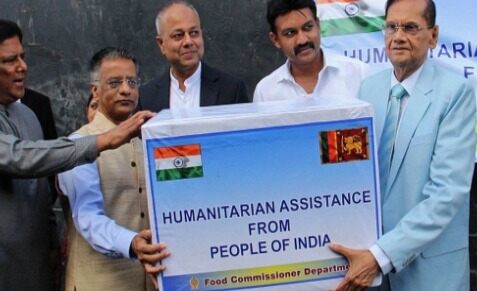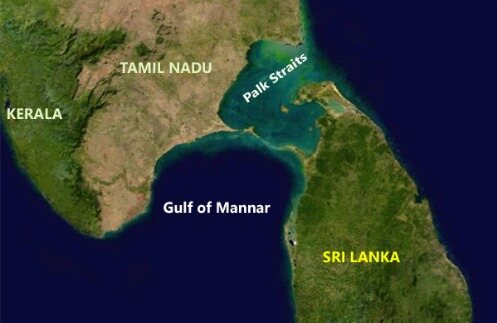India-Sri Lanka relations have deep historical roots intertwined with cultural, economic, and strategic connections. Over the years, both nations have fostered strong diplomatic ties, with frequent high-level visits and exchanges. Economic cooperation between both nations has flourished, with bilateral trade and investment playing a crucial role in their relationship.
Furthermore, cultural exchanges have enriched the bond between the two countries, with shared traditions, languages, and practices contributing to mutual understanding and respect. Despite occasional challenges and differences, both nations have committed to resolving issues through dialogues.
Introduction
The Sri Lankan Sustainable Energy Authority recently inked a deal with Indian firm U-Solar Clean Energy Solutions to construct “Hybrid Renewable Energy Systems” on Delft, Neduntheevu, Nainativu, and Analaitivu islands near the Jaffna peninsula in Sri Lanka.
This initiative, backed by a grant of USD 11 million from the Government of India, aims to enhance sustainable energy infrastructures in these areas. Previously the Sri Lankan cabinet had approved a project from China’s Sinosar-Etechwin Joint Venture for renewable energy projects on these islands, but it has now been replaced by the Indian initiative.
About the project
The Hybrid Renewable Energy System Project in Sri Lanka involves the installation of hybrid renewable energy systems, integrating solar, wind, battery power, and standby diesel power systems. This initiative, supported by India as part of its wider energy assistance efforts in Sri Lanka‘s northern and eastern areas, aims to cater to the energy requirements of the inhabitants of three islands.
The project’s capacity includes 530 kW of wind power, 1,700 kW of solar power, 2,400 kWh of battery power, and a 2,500 kW standby diesel power system. In a geopolitical context, India’s grant assistance replaces a Chinese loan-based project, highlighting the strategic competition between India and China in the Indian Ocean region. Beyond addressing energy needs, this project underscores the geopolitical significance of energy infrastructure in the areas.

Relation of both countries in the past
Relations between both nations have deep historical roots, dating back to ancient times. Cultural ties are strong, with many Sri Lankans tracing their ancestry to India, and Buddhism, originating from India, holding significant influence in Sri Lanka. During a severe economic crisis in Sri Lanka in 2022, India provided approximately USD 4 billion in aid, crucial for the country’s survival.
India has also been instrumental in assisting Sri Lanka with debt restructuring and collaborating with the IMF and creditors. Both nations have a shared vision for comprehensive connectivity, encompassing various sectors like renewable energy, logistics, and port connectivity. Additionally, discussions are ongoing for the Economic and Technology Cooperation Agreement (ETCA) to integrate economies and drive development.
Furthermore, both countries have agreed to establish a multi-product petroleum pipeline, ensuring a reliable supply of energy resources to Sri Lanka, and recognising the pivotal role of energy in economic progress. Sri Lanka‘s adoption of India’s UPI service enhances fintech connectivity, aiding economic recovery.
Also, India ranks as Sri Lanka‘s third-largest export destination, trailing only behind the US and UK, with over 60% of exports under the India-Sri Lanka Free Trade Agreement. The defence cooperation between both nations extends to joint military exercises like SLINEX. Sri Lanka’s involvement in regional groupings like BIMSTEC and SAARC, where India plays a leading role, underscores the bilateral collaboration.

India also emerges as a significant investor, with Foreign Direct Investment(FDI) totalling approximately USD 1.7 billion between 2005 and 2019. Moreover, India remains a key contributor to Sri Lanka‘s tourism sector, with over 100,000 tourists visiting in 2022, making it the largest source of tourists for the country.
Significance of India and Sri Lanka Relations
The significance of both nation relations lies in the regional development focus. Sri Lanka seeks to integrate with the South Asian economy, leveraging its proximity to India’s southern coast across the Palk Strait. Geopolitically, Sri Lanka‘s strategic location at the crossroads of major shipping lanes in the Indian Ocean is crucial for trade and military operations, providing India with significant control.
Advancements in digital payment systems between the two countries will enhance economic integration and simplify business transactions, facilitating trade and boosting tourism connectivity. Through various initiatives such as scholarships, training programs, and educational exchanges, India contributes to enhancing Sri Lanka‘s workforce skills and capacity building.
Challenges of their association
Challenges in both nations include ongoing disputes over fishing rights in the Palk Strait and Gulf of Mannar, leading to tensions and occasional clashes among fishermen and both nations. Another issue is the sovereignty dispute over Katchatheevu Island, compounded by border security concerns and smuggling activities along the porous maritime boundary.
The Tamil ethnic conflict in Sri Lanka remains sensitive, with India closely monitoring the welfare of the Tamil minority. Additionally, India is wary of China’s expanding influence in Sri Lanka, evidenced by significant Chinese investments in infrastructure projects and the Hambantota Port development, which could potentially undermine India’s regional interests.
Recent agreements, such as Sri Lanka‘s deal with China’s EXIM Bank to cover outstanding debt and the Chinese-led Commercial and Logistics Hub at Colombo Port, further highlight this concern.

Conclusion
To ensure seamless progress from planning to execution, it’s vital to conduct regular monitoring and evaluation to track advances, detect any obstacles, and implement necessary adjustments. Engaging local communities throughout the planning and execution phases is crucial, involving them in consultations, capacity-building initiatives, and awareness campaigns to garner their support.
Environmental sustainability should be a priority, necessitating comprehensive environmental impact assessments and the adoption of measures to mitigate adverse effects on local ecosystems and biodiversity. India-Sri Lanka can navigate challenges and capitalise on opportunities to build a more prosperous and stable future together.
-TANYA SHAH
MUST READ: SHOCKING RECESSION OF JAPAN AND THE UK: INDIAN ECONOMY BOOMED